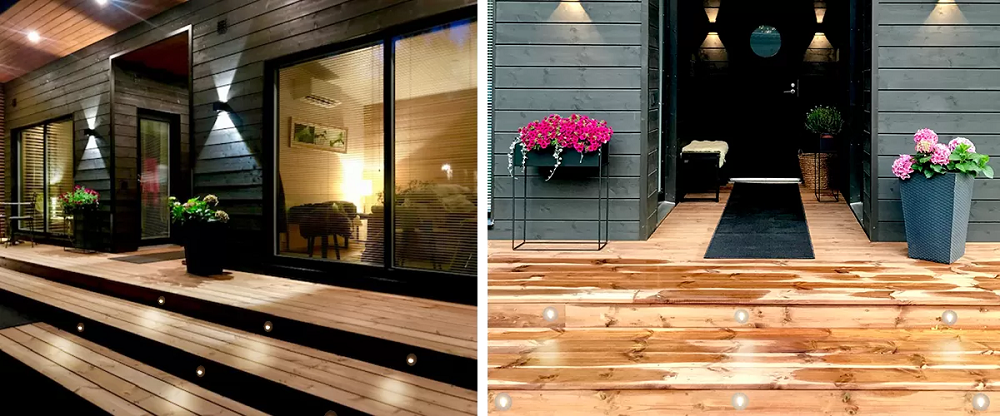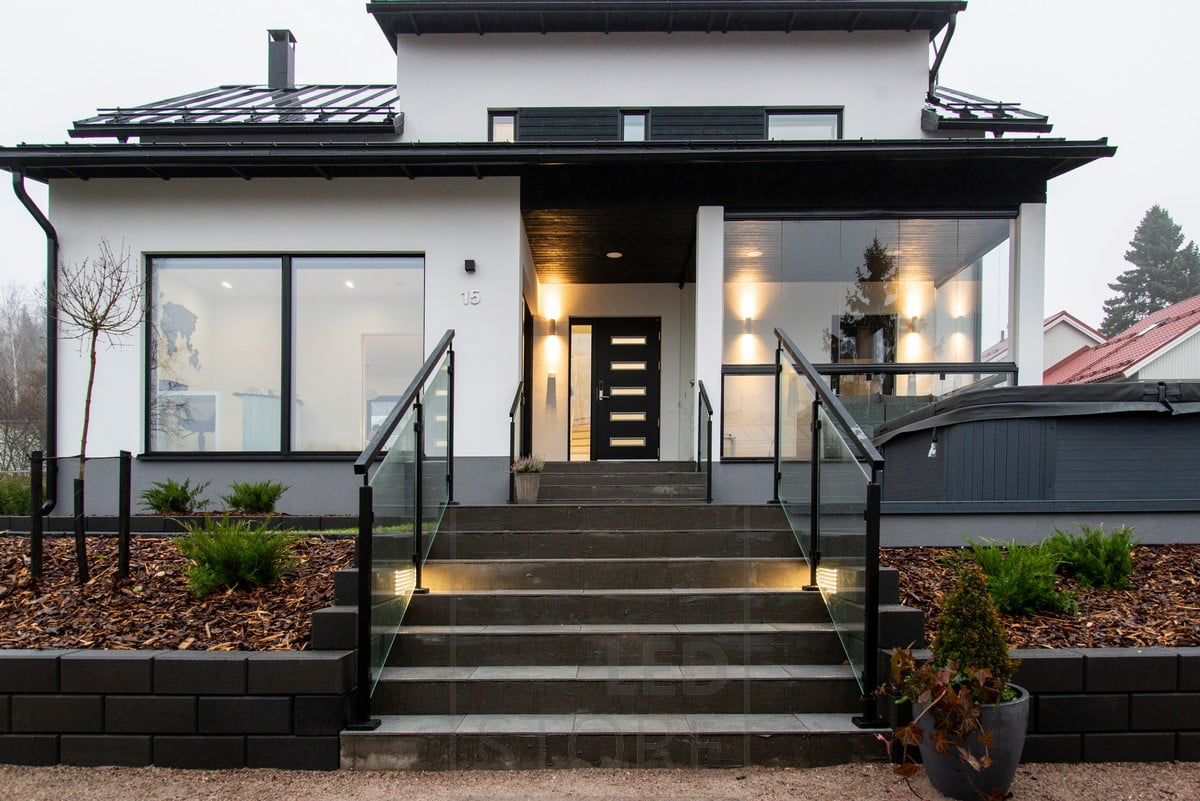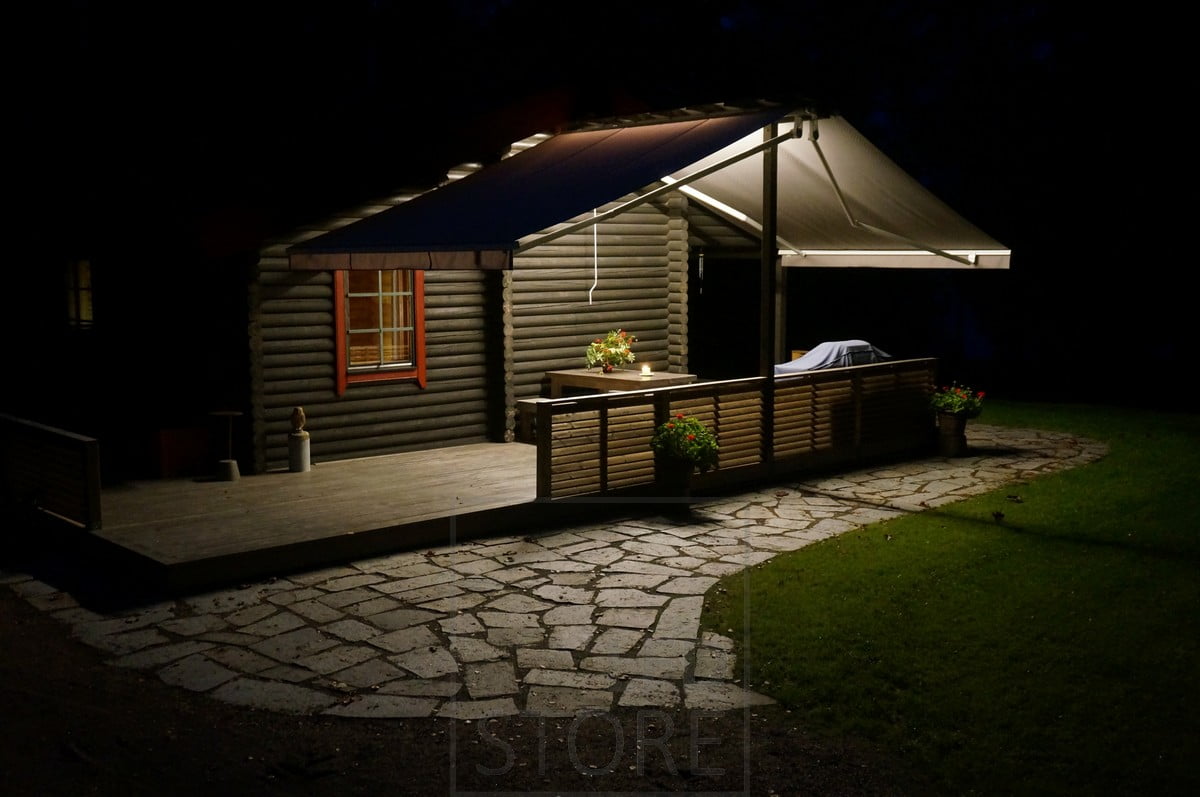Like stars guiding sailors at night, outdoor lighting options light your path home. You face a sea of choices when it comes to outdoor lighting – each with its own strengths and purposes. This guide will help you navigate through energy-efficient LED solutions, discover the benefits of smart lighting, get practical installation tips and compare different outdoor lighting options to find the perfect solution for your home.
Key observations
Light is available for every outdoor space. Consider multi-purpose dimmable LED panel lights for entrances and porches, or choose adjustable LED downlights for high ceilings. Ceiling-mounted LED lights illuminate your entrance, while the stylish and weatherproof LED bulb is perfect for your terrace and roof terrace.
Here are some things to consider:
- LED outdoor lights are energy-efficient and sustainable alternatives for outdoor lighting.
- Path and garden lights improve safety and aesthetics in outdoor spaces.
- Intelligent lighting systems automatically adjust lighting as needed, saving energy and improving convenience.
Outdoor lighting basics
When choosing outdoor lighting, it’s important to understand the basics of the different options so you can find the right solution for your needs. LED outdoor luminaires are popular for their energy-saving features and long life. They provide efficient lighting and can withstand harsh weather conditions, making them a reliable choice.
Solar-powered luminaires offer flexibility and easy installation, as they can be installed without the need for electrical wiring. They are also a cost-effective and ecological lighting solution. By choosing energy-efficient lighting, you can reduce your electricity bills and your carbon footprint. The downside of these luminaires is often their hopelessly poor quality and light output.
For safety and aesthetics, lighting of paths and gardens is key. LED post lights or ground pylons are good options for path lighting.
Terrace lighting, on the other hand, creates a cosy atmosphere and increases the safety of the passageways. When lighting your terrace, take into account the special challenges of winter, such as snow and ice.

When choosing a lamp, also consider the quality of the light. Cold light is better suited to practical lighting, while warmer light creates a more inviting atmosphere. It is by far more popular to choose warm light outdoors.
All in all, outdoor lighting improves the appearance, safety and functionality of your home when chosen correctly. We have written before on the subject of outdoor lighting design.
Energy efficient LED solutions
The energy efficiency of LED lighting can reduce your electricity bills and your carbon footprint. When choosing outdoor lighting, energy-efficient LED solutions help save energy and are an environmentally friendly choice. LED lights consume significantly less electricity than traditional bulbs, which means you can invest in these lights knowing you’ll save money in the long run.
Choosing a luminaire is an important part of your outdoor space design. LED light is often perceived as brighter and cleaner, which also brings a sense of security to your yard or garden. In addition, the long life means that you don’t have to replace your luminaires as often, which is both a practical and financial advantage.
In addition to energy efficiency, LED lighting is versatile; it works well in combination with motion sensors that only light up when needed, saving even more energy. This not only reduces electricity consumption, but also increases comfort and safety. By choosing smart LED solutions, you are making a long-term investment in your own comfort and the well-being of the planet.
Many benefits of smart lighting
Firstly, smart lighting can save energy and thus reduce the burden on the environment. Intelligent lighting systems can recognise when light is needed and automatically adjust it as required. This can lead to significant energy savings.
Secondly, intelligent lighting systems offer their users the possibility to customise lighting according to their needs.
Intelligent lighting solutions not only increase comfort, but also improve safety, as bright and well-directed light prevents accidents and creates a sense of security. You can adjust the brightness of the lights or change the colour temperature, making your outdoor spaces more inviting and versatile.
The transition from traditional to smart
As you move from traditional lighting to smart outdoor lighting, you’ll quickly realise the many ways it can improve the functionality and safety of your outdoor spaces.
Designed to withstand humidity and varying weather conditions, outdoor luminaires are an effective way to illuminate your yard. LED technology helps save energy, and as the lights turn on automatically at dusk, you don’t have to worry about turning them on. You can make any outdoor light smart by adding a dimmer switch or motion sensor. Talking about the Zigbee smart system that lets you control and automate your lights freely.
Overall, smart outdoor lighting is a smart choice. Not only does it make your outdoor space more aesthetically pleasing, it also supports energy efficiency and environmental friendliness. By only using lights when needed, you save both energy and money in the long run.
Practical installation tips
Before installing your outdoor lights, make sure you have a clear plan for placement and the necessary tools at hand. Installation can be quick and easy, as long as you follow a few basic tips. Installing a luminaire is also easy if you choose a model designed for ease of use.

Take note of the following tips:
- Placement: think carefully about where the luminaires will be installed. Are they for path, door or patio lighting? Positioning is important for the functionality of light.
- Safety: you don’t always need to be a professional to carry out a safe installation, but electrical safety must always be ensured. Electrical work should, as always, be left to professionals.
- IP rating: make sure that the IP rating of the luminaire is sufficient for outdoor use. It indicates the resistance of the luminaire to the weather.
- Smart compatibility: if you use smart lights, make sure they can be installed to be compatible with your other smart devices.
By following these tips and considerations, installation is easy and you can enjoy the comfort and safety of outdoor lighting.
Comparison of luminaire types
Now that you understand the basics of installation, it’s time to compare different outdoor lights and find the one that best suits your needs. Outdoor lighting is an important part of your home’s appearance and security, so next we’ll focus on how different types of lighting illuminate and create atmosphere.
LED spotlights IP54 are versatile and dimmable luminaires that are ideal for hallways or porches. The FUNK LED wall luminaire highlights wall materials and provides general lighting for facades. The FUNK column luminaires in the same series are suitable alternatives for lighting paths and garden walkways.
LED lamps are energy efficient and have a long lifetime, making them a sustainable alternative for outdoor lighting.
The following table summarises the different types of lamps and their characteristics:
| Type of luminaire | Features |
|---|---|
| LED spotlights IP54 | Versatile, dimmable, also suitable for outdoor use |
| LED wall lights | Lights up and down, highlights wall materials |
| Pillar/column luminaires | Illuminate paths, suitable for gardens |
| Earthquake | Spot lighting for wood or shrubs |
| Solar cell lighting | Low power decorative luminaire |
Choose a luminaire that will illuminate your terrace and the surrounding area the way you want it, and bring more comfort to your outdoor space.
Frequently asked questions
How do different climatic conditions affect the durability and selection process of outdoor luminaires?
When choosing outdoor lighting, consider the impact of different climates on durability. You need to take into account the effects of temperature fluctuations, UV resistance and antifreeze. Consider the reaction of materials to climatic influences, such as the effects of salt and wind stress. It is important to ensure adequate moisture protection, take into account the effects of snow load and use special coatings to ensure weather resistance. Minimising damage from rainwater is also key to your selection process.
Can I get a lighting plan for outdoor lighting?
Yes, you can seek professional help for outdoor lighting design, which will have a significant impact on the cost. The importance of the lighting plan, the accuracy of the cost estimate and the choice of the right professional will influence the management of your budget. The design process takes into account aesthetic considerations, energy efficiency, light quantity assessment and the unique features of your property. The lighting style should harmonise with these elements to ensure both functionality and visual appeal. More help can be found here
Can outdoor lights be connected to smart home systems?
Did you know that 81% of smart home users consider lighting control to be one of the most useful features? You can integrate your outdoor lights into a non-specific home automation system by checking compatibility, using application integration to achieve intelligent control and ensuring operating system compatibility. Wireless connectivity enables lighting automation, voice control options and energy management features through API interfaces, extending the functionality of your system.
What should be taken into account when installing luminaires on piers?
Safety considerations must be taken into account when installing outdoor lighting. Make sure the lights are waterproof and meet voltage protection and earthing requirements. Position lights carefully to maximise their range and intensity without creating hazards. Use weatherproof materials and follow safety installation codes. These precautions will keep your outdoor areas well lit and safe, even in flood-prone or other high-risk areas.

